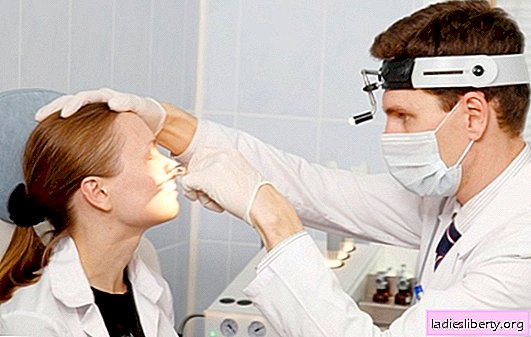
During the off-season, one of the most common health problems, both in children and adults, is the common cold and the common cold.
The "stuffed" nose may also be due to an allergy or a specific reaction of the body to various stimuli. For more information on why the nose does not breathe, as well as what can be done in each of the clinical cases, read on.
Not breathing nose: rhinitis
The most common cause of nasal congestion is a runny nose (rhinitis).
It may appear for various reasons:
• The action of infectious agents. The most common and known factor provoking the "flow" of the nose, is the effect on the human body of pathogens. This could include viruses, bacteria and (rarely) fungi. In some cases, various types of infections "layered" on each other and then the treatment may be delayed. With a high immune status, such a runny nose passes in a few days and does not provide much discomfort to the person. How to distinguish rhinitis of viral and bacterial origin? In the first case, most often, the mucus that is separated from the nose is liquid and transparent, whereas in the second case the snot is a viscid, yellowish-greenish color.
• The action of allergens. The nasal mucosa receptor irritants - dust, pollen, animal dander, etc., can provoke a runny nose. But more often as a result of the action of these agents, the tissues of the upper respiratory tract simply swell, and nasal breathing becomes difficult, without the presence of a mucous membrane.
• Sinusitis, sinusitis and other diseases of the upper respiratory tract. With similar pathologies, snot is thick and yellow-green, or absent, but the head in the forehead area is very sore.
• Otitis and other diseases of ENT organs. Rhinitis can develop in parallel with these diseases.
Not breathing nose: other reasons
Nasal congestion may develop in a different type: a person does not feel the discharge of mucus from the nasal passages, but the air does not pass through them or passes with difficulty.
The reasons for this phenomenon may be several:
• Congenital or acquired (traumatic) disorders (most often - a curvature) of the nasal septum. This also includes abscesses and hematomas. In most of these cases, one nostril does not breathe, while the second air freely passes;
• In the presence of polyps in the nasal passages. Most often, these are benign growths that grow due to allergies or chronic inflammatory processes in the upper respiratory tract. They mechanically interfere with the flow of air. It is also noted that polyps are not rarely combined with pathologies such as asthma, allergies to yellow foods, and to certain medications (aspirin). These tumors are more common in adults, but in children can occur against the background of cystic fibrosis or chronic sinusitis, sinusitis;
• When hitting the nasal passages of foreign bodies. Children often, imperceptibly for parents, put small parts of toys, pebbles, berries from berries and other objects into the nose. Medicine also has cases when parasites (helminths) were in the role of foreign bodies;
• Adenoids or proliferation of the tonsils of the pharyngeal arch. This pathology develops in adults and children suffering from chronic tonsillitis, pharyngitis, laryngitis and other ENT diseases. As a result of this growth, an obstacle is created to the normal flow of air, due to a mechanical obstacle in the internal gaps of the nose moves. This is one of the most common reasons why a child’s nose does not breathe;
• Rhinitis vasomotor. This pathology is not fully understood. Hypothetically, a violation of the nervous regulation of the capillary tone of the nasal mucosa may be the cause. In this case, the nerve endings that promote vasodilation are most active. Due to increased local blood flow, swelling of the nasal mucosa occurs, and the lumen of the nasal passages narrows. Then there are the main symptoms of rhinitis: congestion, sneezing, rarely: the appearance of mucous discharge. Vasomotor rhinitis can be intensified under the influence of low temperatures, dust, chemicals, as well as in nervous shock, stress;
• The negative effect of environmental factors. These include hot air and its low humidity. The fact is that under such physical conditions the function of the nasal mucosa (namely, the ciliated epithelium) is inhibited. The nose can also be blocked due to the effects of low temperatures. For this reason, in winter, when the air in the apartments is dry and heated under the influence of hot batteries, people often do not breathe in their nose;
• Poor circulation in the nasal mucosaprovoked by systemic diseases. These include cardiovascular diseases, pathologies of the kidneys and the endocrine system. Less often, even constipation, alcohol abuse, dysmenorrhea and some other special conditions of the body can lead to the fact that the nose does not breathe;
• Use of certain drugs, most often - nasal drops with vasoconstrictor action. Prolonged irritation of the mucous membrane with such drugs provokes addiction to them, so it is not recommended to abuse them and use them for more than five days. Some agents used to treat hypertension have a similar side effect.
In addition to all the above, women sometimes do not breathe nose when they are in an "interesting position." This is the so-called rhinitis of pregnant women, which passes after childbirth. If the child’s nose does not breathe (in the first or second year of life) - this may be the physiological state of the body, and also it is necessary to check if his teeth are being cut (in this state, a runny nose is a common phenomenon).
The nose does not breathe: acute and chronic rhinitis stages
In children and adults in about 70% of cases, the acute form of rhinitis occurs against the background of colds (ARVI, ARI, flu). This form of rhinitis proceeds in three stages:
1. Reflex or "dry" stage. The body has just or still suffers hypothermia or another stressful condition, which reduces its immune status. At the same time, capillaries of the nasal mucosa are greatly expanded, which is manifested in severe dryness, and then - the appearance of swelling and nasal congestion.
2. Catarrhal stage. Due to reduced immunity, the body is attacked by viruses, penetrating through the epithelium of the nose. In connection with this, the function of mucus producing glands is activated. Symptoms such as lacrimation, sore throat, ear congestion may be added;
3. Stage of action of bacterial agents. It can be recognized by mucus that has changed color and consistency: it turns from transparent and liquid into thick and yellow-green.
Chronic form develops due to improper treatment of acute rhinitis. It can be provoked by frequent allergic reactions, systemic diseases, harmful conditions at work, adverse environmental factors, etc. Chronic rhinitis can be allergic, vasomotor (mentioned above), as well as atrophic and hypertrophic.
Atrophic Chronic Rhinitis - This is a pathology, which is characterized by thinning of the nasal mucosa, with the expansion of the lumen of the nasal passages. The function of the tissues is disturbed, viscous mucus starts to stand out from the nose, which dries out, forming crusts, and the person loses the sense of smell. Additional symptoms can be tickling in the throat and nasopharynx, itching. When you try to remove such crusts yourself, small bleedings may open, on the site of which ulcers later form. Infection can get into such wounds (most often staphylococcus, Klebsiella).
Hypertrophic Chronic Rhinitis - a form of rhinitis, which is characterized by the growth (hyperplasia) of the nasal mucosa and nasopharynx on the background of chronic inflammation. The lumen of the nasal passages significantly decreases and even overlaps, in connection with which a person is forced to constantly breathe through his mouth. In parallel with this, compression of the nasolacrimal canaliculi may occur, the lacrimal fluid does not flow normally. Therefore, there is a constant flow of tears, not associated with the emotional state of a person, and inflammatory diseases of the eye membranes (conjunctivitis, etc.) can also occur. Often, people suffering from hypertrophic chronic rhinitis suffer from headaches.
Not breathing nose: what to do?
The first thing to do with a stuffy nose is to determine the cause of this trouble. The therapist or the ENT specialist is dealing with this issue. If the reason is not obvious, some diagnostic measures may be needed, for example:
• Blood test - general, biochemical, immunogram;
• Definition of the patient's allergostatus;
• ultrasound or x-ray of the paranasal sinuses;
• Bacteriological culture from the nasal passages.
In some cases, the patient may be recommended to consult narrow specialists: a dentist, a neurologist, an endocrinologist, etc.
Do not breathe nose: what to do and how to treat at home
Treatment of nasal congestion with a common cold is not particularly difficult and can be carried out independently. For this, nasal drops with vasoconstrictor action can be purchased at any pharmacy.
The range of these drugs is quite extensive. The most popular are drops, with active ingredients oxymetazoline (Nazol, Noksprey, Nazivin, etc.), naphazoline (Sanorin, Naphtizinum, Naphazoline, etc.), xylometazoline (Evkolin, Nosolin, Galazolin, Rinostop, etc.). Different active substances affect the nasal mucosa in different ways: naphazoline dries and acts for 4-6 hours, Xylometazoline moisturizes and has a slightly longer period of action, oxymetazoline gently affects the mucous membrane and helps for 12 hours.
In addition to vasoconstrictor drops, it is advisable to apply moisturizing solutions and sprays. Pharmaceuticals can offer a solution of sea salt: AquaMaris, Salin, Physiomer, Aqualor, etc. Such agents not only moisturize the mucous membrane, but also reduce its inflammation, thin the thick discharge. Instead of these drugs, you can use the usual saline solution for washing the nose. With the help of sea salt drops alone, it is impossible to get rid of nasal congestion, but they help to eliminate this unpleasant symptom more quickly.
If the child’s nose does not breathe, homeopathic medicines and traditional medicine remedies stand apart. This may include the balsam "Chinese star" and other drugs containing menthol in its composition. Such tools refresh and facilitate breathing, can be used as adjuvant therapy in adults.
If not breathing nose, what to do (several safe and affordable folk remedies and techniques):
• Massage. It is possible to alleviate the condition if you independently massage the areas of the nose, the paranasal sinuses, temples, superciliary arches, the wings of the nose. Such movements contribute to blood flow, dilution of mucus and removal of swelling of the nasal tissue;
• Warming up the nose and paranasal sinuses. As a "hot water bottle" you can use a bag of table salt or freshly cooked chicken egg. However, this procedure is not recommended for sinus and rhinitis, provoked by a bacterial infection;
• Steam inhalation. Everybody knows from childhood how to inhale steam from boiled potatoes. Inhalation of infusion of calendula, chamomile, and essential oils will also be effective.
In addition, due attention should be paid to the hygiene of the nasal passages. You need to regularly clean your nose, blowing "snot." This should be done alternately - first, to clean one nostril, then another, while blowing too hard is impossible, because in this case, creates excessive pressure, and mucus can penetrate into the middle ear through the Eustachian tube.
Antiviral homeopathic immunomodulators: Ocillococcinum, Corisolium, Sinupred, etc.
Remember that doctors do not recommend practicing any folk remedies or self-medicating. The above listed drugs and recommendations are for guidance only and are not a guide to action.
Not breathing nose in a child and an adult: traditional treatment
In addition to vasoconstrictor drugs, based on the results of tests and examinations, specific drugs can be prescribed by a doctor.
Among them:
• Antiviral drugs. If rhinitis is known to have provoked the virus;
• Antibiotics - both local (in the form of drops) and general (in the form of tablets, injections, etc.), if the nose does not breathe due to the effect on the body of a bacterial infection;
• Anti-inflammatory drugs - in the presence of adenoids, polyps in the nasal sinuses, in hypertrophic rhinitis, sinus and some other diseases;
• Mixed drugs. Such funds are sold strictly by prescription and are used only on the recommendation of a doctor. Their composition most often includes vasoconstrictor and hormonal component. Such remedies help with allergic and vasomotor rhinitis;
• Preparations containing silver ions. Such nasal drops are made in special pharmacy laboratories, their shelf life is only 24 hours. One of such means is Protargol. These drugs are used if the nose does not breathe in a child, in pregnant women.
And, of course, if for certain the reason is known why the nose is not breathing, these factors should be excluded:
• Effects on the body allergens;
• Diseases of ENT organs;
• Curvature of the nasal septum or other congenital or acquired anomalies of the structure of the respiratory tract, which are surgically removed;
• Polyps, adenoids or other neoplasms. In this case, surgery may be required;
• Systemic diseases.
If your nose is not breathing for a long time (7-10 days), what to do is to run for an appointment with an ENT. Tightening up with a visit to a specialist is not even more so if the condition is complicated by pain in the ears, throat, nose, eye sockets, and temples. If you notice that nasal congestion is strictly seasonal (during the flowering of plants), an immunologist and allergist can help.
Remember that each case of acute or chronic rhinitis requires an individual approach. Do not tighten with an appeal to a specialist, then you can completely get rid of nasal congestion and live fully!











